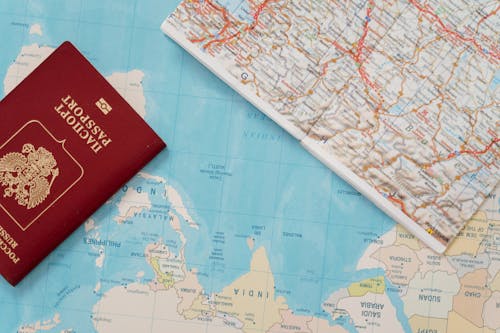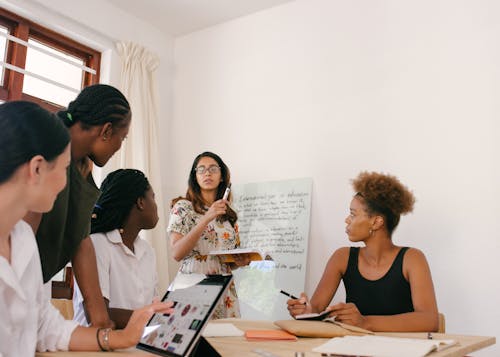Do you want to work in the USA and don’t know where to start? The world of work visas can be very intimidating, so I prepared this simple guide to help you determine which work visa is the best for you. It doesn’t matter if you have an academic degree or not; there are options of all kinds, and here I will tell you about them because I know how much opportunity it holds for your life and your family’s. So it’s essential that you have the best information about it.
In this blog, I will explain what a work visa is, the different types of work visas, and how to apply for temporary and permanent work visas.
What Is a Work Visa?

It is a type of visa required by the United States before any international applicants may enter the country and begin looking for employment there. You will have to meet several qualifying conditions to qualify for a work visa, which changes based on which country you want to work in.
Key Points
- Various U.S. work visas exist for different employment needs, including temporary non-immigrant visas like H, L, O, and P visas and permanent worker permits such as EB-1 to EB-5 visas.
- Each work visa has specific eligibility requirements based on the applicant’s skills, the employer’s credentials, and the job’s
- Applying for temporary and permanent work permits involves multiple steps, including employer petitions, USCIS approval, and visa interviews.
- Costs vary, with significant fees for forms like I-140 and I-485, plus additional expenses for biometric services and document translations.
Types of U.S. Work Visas
There are various types of U.S. work visas you can apply for as a Nigerian. They include the following:
#1. Temporary Non-immigrant Visa
If you want to work in the United States for a specific period, this is the right work visa to apply for. In most cases, the employer files a petition for this type of work with the U.S. Citizenship and Immigration Services (USCIS) and before coming to the U.S., the employee would still need to apply for a visa. Spouses and family members of holders of these employment visas need to file for their visas before coming to the U.S. Below are the most common types of non-immigrant work visas:
- H Visas
H-1B visas are made specifically for people in specified professional or academic fields or with special expertise who have a degree, either a college degree or higher or the equivalent in work experience. With this type of visa, you have a residency cap of just three years. To be eligible for this type of visa, you must either have a job offer from a U.S. employer for a role that requires speciality knowledge or proof of a bachelor’s degree or equivalent in that field, or your employer must provide evidence that there is a lack of qualified U.S. applicants for the role.
H-2A and H-2B visas are made for seasonal or peak-load temporary workers in an agriculture (H-2A) or non-agricultural (H-2B) setting. Note that this type of visa doesn’t exceed a year. H-3 classification is for citizens who want training within the United States but will be pursuing their careers outside of the U.S.
- I Visas
They are made for members of the press, including reporters, film crews, and similar occupations, representing a foreign media outlet such as print, film or other foreign information media when the outlet has a home office in a foreign country. For most, this is an indefinite visa as long as the holder is engaged in this profession for the same company.
- L visas
It is meant for people temporarily transferring within a company they already work for, either at L-1A, which is the executive manager or L-1B, which is specialised expertise. An L-1A visa lasts three years; an L-1B visa lasts only one year.
- O Visas
This type of visa is made for people with exceptional and extraordinary abilities or achievements, or those travelling with a person of extraordinary ability or a family member.
Advertisements
- P Visas
There are usually event-based durations and are made for people who excel in performance, athletic, or artistic endeavours and the people who accompany these extraordinary performers.
- R visas
R visas are extended to non-immigrant religious workers who are members of a religious denomination that holds official non-profit status in the U.S. and are coming to work either directly for that denomination or an associated non-profit.
What Are the Eligibility Criteria for Temporary Worker Permits?
Due to the various and wide-reaching nature of US temporary worker permits, each permit will have its own specific eligibility criteria that you will have to fulfil. However, generally speaking, eligibility criteria for permits may cover the following key areas:
- Your own skills, knowledge, talent, or occupations, and if they fit within the necessary requirements of that specific permit.
- Your employer or sponsor and if they fit the eligibility criteria for that specific permit.
- The nature of the work you intend to do in the US and if it’s valid under that specific permit.
- Your eligibility to enter the US is based on the country’s general immigration guidelines.
- If your employer has successfully obtained a Labour Condition Application (LCA) certified by the Department of Labour (if necessary),.
It’s important to carefully read the eligibility criteria for each permit to ensure that you have met all of the requirements before applying.
How Can I Apply for a Temporary Worker Permit?

Most temporary worker permits will require your employer to submit a petition to USCIS on your behalf. The only work permit listed in the previous list that does not have this requirement is the I Representatives of Foreign Media work permit.
The employer must fill out Form I-129, Petition for a Nonimmigrant Worker. They may also have to provide additional information to USCIS at this stage in order to successfully have the petition approved. Once USCIS approves the petition, you will receive a Notice of Action, Form, or Petition Receipt number.
Advertisements
You will then need this to apply for your chosen temporary work visa from the US Department of State (DOS). You must fill out Form DS-160 (Nonimmigrant Visa Application), pay the fees, and schedule an interview with your local US embassy or consulate. Interviews are mandatory for all applicants aged 14 to 79.
For Nigerian citizens, there are two US consulates operating in Abuja and Lagos. After your interview, the consular officer will review your application and either approve or reject your visa application.
What Are the Required Documents for a Temporary Worker Permit?
The documents you will need to submit with your temporary worker permit may include the following:
- Confirmation page of Form DS-160
- appointment confirmation page (if necessary)
- valid passport or travel document with at least one blank page
- a valid passport-sized photograph of yourself
- evidence of your status in Nigeria
- evidence of any previously issued US visas
- the receipt number of your approved petition
- details of any previous criminal history or criminal convictions
- details of any medical details that may affect your visa application.
- Details of any previous deportations or removals from the US
- A letter from your employer detailing your role, your relationship to the company, and the nature and duration of the work you intend to carry out in the US (only for Representatives of Foreign Media applicants).
What Are the Fees and Processing Times for a Temporary Worker Permit?
If you’re applying for a temporary worker permit that requires your employer to submit a petition, the cost of a work permit will be 296, 225 naira ($205). If you’re applying for a temporary worker permit that doesn’t require a petition (i.e., the Representatives of Foreign Media work permit), the cost of a work permit will be 267,326 naira ($185). You may also have to pay an additional 122,825 naira ($85) for biometric services or if you need to have your documents translated into English. The cost for an employer to file Form I-129, Petition for a Nonimmigrant Worker, is 664,700 naira ($460).
Processing times for temporary worker permits will vary based on which embassy or consulate you apply with and if there are any complications with your application. However, you can expect your worker permit to be processed within a few days or a few weeks.
#2. Permanent Workers

Permanent residence in the U.S. can be obtained through the right combination of education, expertise, eligibility, and skill set. Those with the right job skills and their spouses and children can apply for the roughly 140,000 employment-based green cards available each year. Most of these visas call for an existing offer of employment from an employer who has the proper U.S. Department of Labour certification, verifying that there are insufficient workers with this skill set within the United States, and the hiring does not take a job away from a U.S. citizen called “labour certification.” This is done through ETA Form 9089 ( “Application for Permanent Employment Certification”). There are five key types of employment-based visas:
- First Preference: EB-1
EB-1 covers those with “extraordinary ability,” such as business professionals, academics and researchers, scientists, the arts, or athletics. This type of visa does not require labour certification. A family of EB-1 visa holders may apply for admission to the U.S. on an E-14 or E-15 immigrant status, respectively, if that person has an approved I-140 (green card) form.
- Second Preference: EB-2
EB-2 visas are available to professionals holding an advanced degree or foreign equivalent who can prove at least ten years of experience in a field or whose employment is in the national interest of the U.S. For all but the third category of eligibility, labour certification must be obtained. A family of EB-2 visa holders may apply for admission to the U.S. through E21 or E22 forms if that person has an approved I-140 form.
- Third Preference: EB-3
EB-3 visas are available to those holding a bachelor’s degree or foreign equivalent, as well as skilled and unskilled labourers who have a non-temporary offer of employment from a U.S. employer. For each eligibility category within EB-3, labour certification must be obtained. Families of EB-3 visa holders may apply for admission to the U.S. through specific spouse or child forms listed here if that person has an approved I-140 form.
- Fourth Preference: EB-4
EB-4 visas are a specialised category of visa, whose eligibility includes but is not limited to certain religious workers, employees of U.S. foreign service posts, retired employees of international organisations, and noncitizen minors who are wards of courts in the United States. Labour certification is waived for this type of visa.
- Fifth Preference: EB-5
EB-5 visas cover the immigrant investor programme. These are available to people who make either an investment of 2.6 billion naira (1.8 million USD) in a new commercial enterprise that employs at least 10 full-time U.S. workers or 1.3 billion naira (900,000 USD) in a new commercial venture in a targeted employment area that employs at least 10 full-time U.S. workers. Under the programme, investors and their families are eligible to apply for green cards.
How Can I Apply for a Permanent Worker Permit?
There are several steps involved in applying for a permanent work permit. The first step, if it applies to you, is for your employer to obtain a labour certification from the U.S. Department of Labour.
A labour certification will prove to USCIS that there is a shortage of available, qualified, and willing American workers to fill the role. It will also demonstrate that hiring a foreign worker won’t adversely affect the wages and working conditions of similar workers in the US.
The next step is for the employer to file a petition with USCIS, if necessary. They must do this by filing Form I-140, Immigrant Petition for Alien Workers. They may also have to provide additional information to USCIS regarding the specific eligibility criteria for the visa being applied for to have the petition approved.
After the petition has been approved, you will then need to apply for your chosen visa with the US Department of State (DOS). This may involve attending a medical examination and a visa interview at your local US embassy or consulate. Interviews are mandatory for all applicants aged 14 to 79.
For Nigerian citizens, there are two US consulates operating in Abuja and Lagos. After your interview, the consular officer will review your application and either approve or reject your visa application.
What Are the Required Documents for a Permanent Worker Permit?
The documents you will need to submit with your permanent worker permit may include the following:
- Form DS-260, Immigrant Visa and Alien Registration Application
- appointment confirmation page (if necessary)
- valid passport or travel document with at least one blank page
- a valid passport-sized photograph of yourself;
- evidence of any previously issued US visas
- the receipt number of your approved petition
- details of any previous criminal history or criminal convictions
- details of any medical details that may affect your visa application
- details of any previous deportations or removals from the US
- proof of financial support
- medical examination forms.
What Are the Fees and Processing Times for a Permanent Worker Permit?
The cost of filing Form I-485, Application to Register Permanent Residence or Adjust Status, is $1,140. Employers will also have to pay $700 to file Form I-140, Immigrant Petition for Alien Workers.
- You may also have to pay an additional 122,825 naira ($85) for biometric services, or if you need to have your documents translated into English. Processing times for permanent worker permits will vary based on which embassy or consulate you apply with and if there are any complications with your application. However, you can expect your worker permit to be processed within a few weeks to several months.
#3. Student and Exchange Visitors

These visas cover three types of students: academic students, vocational students, and those enrolled in educational or cultural exchange programmes. These are not immigrant visas.
- F Visas
F-1 visas are for academic students enrolled at accredited academic institutions. As long as a course of study is maintained, students may work. Students cannot work off-campus during the first academic year but may accept on-campus employment, subject to conditions and restrictions.
After the first academic year, F-1 students can engage in three types of off-campus employment: curriculum practical training (CPT), optional practical training (OPT) (pre-completion or post-completion), and science, technology, engineering, and mathematics (STEM) OPT. F-2 visas are available for the family of the student, including the spouse and children. F-3 visas are available for Canadian or Mexican students who commute.
- M Visas
M visas are available for students at vocational or other recognised nonacademic institutions, other than language training programmes (which require an F visa). M-2 visas are available for the family of the student, including the spouse and children. M-3 visas are available for Canadian or Mexican students who commute.
- J Visas
J visas are available for those involved in work- and study-based programmes, like au pairs, camp counsellors, trainees, interns, and more. Programmes must promote cultural exchange and applicants must meet eligibility criteria, including English language proficiency. J-2 visas are used for dependents of the J-1 visa holder.
#4. Temporary Visit for Business
These visas are for very short-term business purposes. If a person were, for example, negotiating a contract, attending a convention, or settling an estate, they would travel under this type of visa.
- B-1 Visas
B-1 visas are for those conducting limited, short-term business in the United States. These demand a specific period and are usually given for a one- to six-month period, with a possible extension of an additional six months. It is rare if these visas extend beyond one year. Families of B-1 visa holders are not eligible to travel under these visas; they must obtain their own B-1 visas to travel.
- GB Temporary Visitor to Guam
GB Temporary Visitor to Guam visas cover the U.S. territories of Guam and the Northern Mariana Islands. Visa holders may be travelling for business or pleasure, but they need to be travelling with a return ticket. The stay cannot exceed 45 days.
- WB Temporary Business Visitor under Visa Waiver Programme
The WB Temporary Business Visitor under the Visa Waiver Program allows nationals of 39 countries, specified by the State Department, to travel to the U.S. for business or tourism without a visa for a period of 90 days or less.
This is a more concise checklist on this:
Work Visa.pdf
What Are the Benefits of Having a Work Visa?
U.S. work visa holders can legally work, obtain social security benefits if applicable, travel within the U.S. and access most of their rights as U.S. citizens or permanent residents.
Who Can Sponsor a Work Visa?
To be eligible to sponsor an immigrant for work, you must be up to 18 years old, be a U.S. citizen or green card holder or reside in the U.S. or one of its territories.
How Long Does It Take to Sponsor a Work Visa?
This can take anywhere from six months to several years to complete. Obtaining approval from the U.S. Citizenship and Immigration Services (USCIS) for an I-140 petition on behalf of the foreign worker.
Conclusion
In conclusion, going through the process of obtaining a work visa can be complex, but when you have the right information and guidance, it becomes a whole lot easier. You need to first understand the eligibility requirements. Whether you are seeking a temporary or permanent work visa, it is very crucial that you understand it first before anything else. If you follow the steps outlined above, you can increase your chances of successfully increasing your work visa. Good luck!
Related Articles
- France Visa Application: Avoid These Critical Mistakes or Risk Denial
- The Ultimate Schengen Visa Application Checklist: Steps Most People Miss
- How to Apply for a Green Card as a Nigerian
- Top Tips for Nigerians Applying for a National Interest Waiver
Reference
Advertisements






